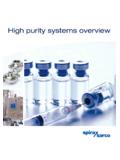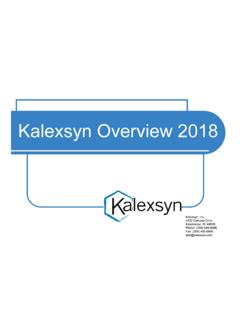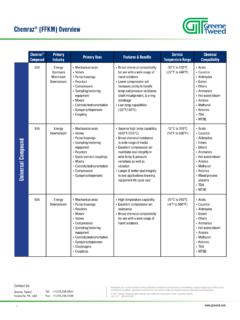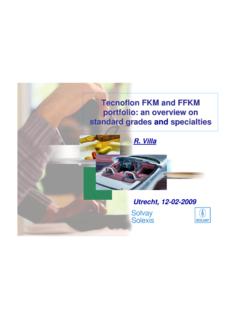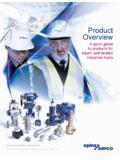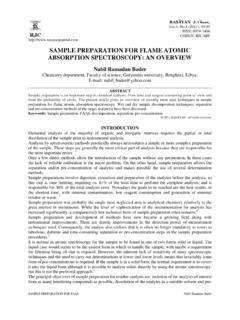Transcription of Condensate Polishing - Veolia Water
1 Condensate Polishingwith SeparIX External RegenerationWATER TECHNOLOGIESWhy Polish Condensate ? Polishing Condensate reduces the risk of damage to the boiler and the turbine caused by the concentration of soluble impurities that corrode internals which contribute to insoluble impurities such as copper, iron and silica in the re-circulating stream. In addition, the Condensate polisher protects the system against condenser leaks: allowing continued operation for low TDS cooling waters and giving operators time to shut down the boiler for high TDS cooling with Condensate polishers can also be started up more quickly. Saving the utility time and money and allowing more flexibility of Bed Ion ExchangeVeolia has been designing, building and commissioning Condensate Polishing plants for over 30 years.
2 Using this knowledge base, a range of standardized mixed-bed units for Condensate Polishing has been created. Standardized units reduce time to market, optimize cost, facilitate maintenance and represent proven (m3/h / gpm)StandardsS150 250 / 660 1100 ASME, PEDM250 500 / 1100 2200 ASME, PEDL500 750 / 2200 3300 ASME, PEDXL750 1000 / 3300 4400 ASME, PEDS eparIX External RegenerationExhausted mixed bed resins are typically regenerated externally to fulfill the highest purity newly developed SeparIX technology is a simple and exceptionally robust process using a high degree of separation to externally regenerate the mixed bed resins of Condensate Polishing plants.
3 The system consists of two vessels for resin separation and regeneration as well as a third vessel for interim storage of the interface to previous solutions, SeparIX does not require difficult and costly sensor technology or additional chemicals as its separation process is based solely on the physical characteristics of the resins. The high purity of regenerated resins enables ammonia cycle Operation OverviewExhausted mixed bed resins are pre-regenerated to achieve constant resin layer heights in the separation vessel, independent from their grade of exhaustion. Only after regeneration are resins separated. This process eliminates the need for costly sensors or specialty chemicals to identify and separate the resin types.
4 The anion resin, on top of the interface zone, is transferred to the anion regeneration vessel. The interface zone, in between the anion and cation resins, is then withdrawn from the separation vessel and stored temporarily in the interface resin vessel, to be re-used in the following regeneration designed resin collectors separate and transfer anion and interface resins to prevent mixing and contamination of the resin Solo For plants with less stringentrequirements for condensatepurity, a single column versionof SeparIX exists. This moreeconomical approach is similarto in-situ Veolia Water Technologies? Veolia has over 30 years experience in providing Water treatment systems to the power industry.
5 The company is uniquely positioned to meet all Water cycle business units have full technical capabilities and are backed by a global support has extensive experience in Condensate Polishing systems with references for both in-situ and externally regenerated plants. Markets served include Power, Pulp & Paper, Chemicals and Flow Diagram CPP with SeparIXLatest References400MW Combined Cycle Plant in South KoreaVeolia supplied two treatment lines for a 50/50 split. Each line treats 198m3/hr of Condensate using mixed beds in the hydrogen form with external regeneration via Heating Plant in GermanyVeolia supplied mixed bed units and SeparIX Solo to treat two lines of Condensate .
6 Each line has a flow rate of 205m3 Veolia Water Technologies Communications / Veolia Water Technologies Photo LibrarySpecially designed resin collectors separate and transfer anion and interface resins to prevent mixing and contamination of the resin Operation OverviewProcess Flow DiagramCPP with SeparIXLatest ReferencesSeparIX Solo Why Veolia Water Technologies? Exhausted mixed bed resins are pre-regenerated to achieve constant resin layer heights in the separation vessel, independent from their grade of exhaustion. Only after regeneration are resins separated. This process eliminates the need for costly sensors or specialty chemicals to identify and separate the resin types.
7 The anion resin, on top of the interface zone, is transferred to the anion regeneration vessel. The interface zone, in between the anion and cation resins, is then withdrawn from the separation vessel and stored temporarily in the interface resin vessel, to be re-used in the following regeneration Combined Cycle Plant in S KoreaVeolia supplied two treatment lines for a 50/50 split. Each line treats 198m3/hr of Condensate using mixed beds in the hydrogen form with external regeneration via Heating Plant in GermanyVeolia supplied mixed bed units and SeparIX Solo to treat two lines of Condensate . Each line has a flow rate of 205m3/hrFor plants with less stringent requirements for Condensate purity a single column version of SeparIX exists.
8 This more economical approach is similar to in-situ regeneration. Veolia has over 30 years experience in providing Water treatment systems to the power industry. The company is uniquely positioned to meet all Water cycle requirements. Local business units have full technical capabilities and are backed by a global support network. Veolia capabilities for Condensate Polishing have been proven in Power, Pulp & Paper, Chemicals, Petrochemicals and other - External RegenerationAcidCausticCartridgeFiltersM ixed Bed exchangers08/2014 Veolia Water Technologies Communications / Veolia Water Technologies Photo Library








